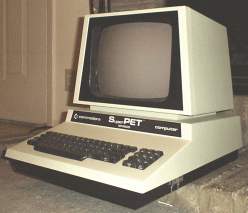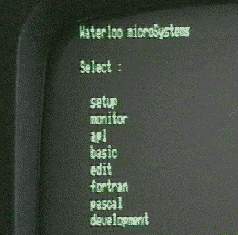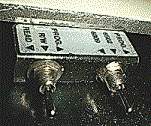Commodore

SuperPET SP9000
 The top of the PET line of computers was a project of the University
of Waterloo in Canada. What they produced is remarkable indeed. Based
off top-of-the-line Commodore PET technology, the SP9000
(also known as the MicroMainframe) sports 96K of RAM, true RS232,
full 8032/8096 compatibility, and an architecture
and software package that make it a developers' power machine!
The top of the PET line of computers was a project of the University
of Waterloo in Canada. What they produced is remarkable indeed. Based
off top-of-the-line Commodore PET technology, the SP9000
(also known as the MicroMainframe) sports 96K of RAM, true RS232,
full 8032/8096 compatibility, and an architecture
and software package that make it a developers' power machine!

When powered on in its Programmer mode, the SuperPET brings up the menu
you see here, allowing you to select from its assortment of powerful
programming languages and development tools. The idea behind the machine
was that developers and academic types could do their work
at home on the SuperPET. That work could then be uploaded back
to an IBM mainframe using a direct RS232 connection as a terminal.
The powerful packages, as seen in the menu, include: RS232 configuration (Setup),
a Machine Language Monitor, an APL development package, a BASIC development
package (in addition to the standard Commodore BASIC), a powerful
text editor/terminal program, a Fortran development package,
a Pascal development package, an Assembler development package, and
(not listed) a COBOL development package.
There's much more on all of these below.
Be sure to check out the PET 2001 entry for more
general information on Commodore PET computers.
Statistics, features, and SuperPET resources:

| CPU |
MOS Technology 6502 AND 6809
1 Mhz
|
| RAM |
96k standart
64K was contained on an expansion board above the motherboard.
Early SP9000 models had two boards above the motherboard
Some models also had 3 or more switches.
|
| ROM |
48 kilobytes
Waterloo KERNAL, including CBM Basic 4.0
(Download 50hz ROM images)
(Download 60hz ROM images)
|
| Video |
MOS Technology 6545 CRTC
12" Monochrome displays
80 columns x 25 rows
(3+) character sets (256 characters each)
|
| Sound |
Piezo electronic speaker
One square wave voice
Three octaves.
|
| Ports |
IEEE-488 edge-connector Port
2 Commodore Datasette ports
Male edge-connector 'EXPANSION' port
25-pin RS232 Female DIN port (Internal)
Male edge-connector CBM parallel programmable "User" port
Memory and Processor selection switches
|
| Kyboard |
Full-sized 73 key QWERTY
Multi-Font 62 key keyboard
APL Symbols on the front of the keys
11 key numeric keypad
Editor functions on the front of the keys
2-key 4-direction cursor-pad
|


